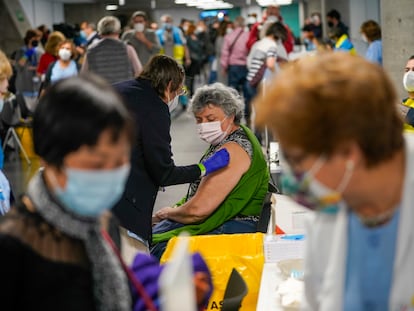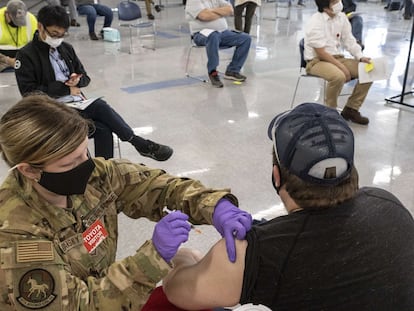Spain reports more than 10,000 new coronavirus cases as fourth wave takes hold
While contagion rates are rising in most of the country’s regions, they are falling in Valencia, Galicia and Murcia, where the epidemic is more under control


The fourth wave of the coronavirus pandemic is consolidating in Spain. The Health Ministry on Wednesday reported 10,474 new infections and added 131 victims to the overall death toll. Meanwhile, the 14-day cumulative number of coronavirus cases per 100,000 inhabitants has risen to 201. “We have been seeing a rising trend, a slow but continuous rate of growth,” admitted Health Minister Carolina Darias on Wednesday.
The transmission of the virus is rising in nearly all of the country’s regions, apart from in the Canary Islands and in those territories where the incidence was already very low – i.e. Valencia, Galicia, Murcia and the Balearic Islands (all with fewer than 100 cases per 100,000 inhabitants). For the second day in a row, however, the number of people being treated in hospital with Covid-19 has fallen slightly, although the pressure on the country’s intensive care units (ICUs) continues to be high. There are currently 9,795 patients in ordinary wards and 2,153 in ICUs.
The rhythm of new infections varies greatly from region to region. In Navarre, for example, the incidence has risen 238% since March 16, when the curve stopped its downward trajectory. This is compared to the average rise in Spain since that date of 57%. Currently, Navarre has the worst incidence rate, at 433.76, only behind the North African exclave cities of Ceuta and Melilla, which both are at 522 cases per 100,000 inhabitants.
In Madrid, Catalonia and La Rioja around 40% of available beds are occupied by Covid patients, a much higher figure than the 25% which is already considered high risk
Madrid, which has an incidence rate of 347, two points above that of the Basque Country, is facing this new wave from an already-dangerous situation. The incidence in the central region has not fallen below 200 cases per 100,000 inhabitants since August. In total, there are eight regions in Spain with an incidence above 200.
On the other end of the scale, the four regions with a cumulative incidence below 100 are holding steady. The Balearic Islands (59) has seen little change over the last day, while Valencia (34.9), Galicia (77) and Murcia (65.6) have fallen slightly. These regions have opted for a very gradual deescalation of measures, and despite the good data that is being reflected by their epidemiological curves, are maintaining strict measures such as limited capacity inside restaurants, earlier closing times for establishments and perimetral lockdowns.
Health Minister Darias has called for the regions to adopt the restrictive measures needed to bring the incidence below 50 cases for the whole country. “What this minister is calling on all of the regions to do, in particular in the case of Madrid because Navarre is already doing so, is to observe the measures included in the coordinated action document, the so-called traffic-light document,” she said on Wednesday, in reference to the levels of risk set out by the Spanish government. In that report, the ministry recommends the closure of the inside of restaurants and bars in areas if certain criteria are met, such as an incidence above 150 cases per 100,000 inhabitants and more than 15% of ICUs occupied by Covid-19 patients, among other indicators.
Pressure on hospitals remains high, despite the aforementioned fall in patients seen in recent days. Darias, however, expressed her “concern” yesterday over ICU occupation, where one in five beds in Spain is occupied by coronavirus patients. She explained that some regional health chiefs voiced their concern yesterday given that the average time a person with Covid-19 spends in the ICU is very long. In Madrid, Catalonia and La Rioja around 40% of available beds are occupied by Covid patients – more than 25% is considered high risk, according to the ministry’s traffic light system.
Since the start of the pandemic, there have been 76,756 official victims, although the real figure is likely much higher given the amount of people who died during the first wave without being diagnosed. According to Wednesday’s report, there were 265 Covid-19 deaths over the last seven days.
English version by Simon Hunter.
Tu suscripción se está usando en otro dispositivo
¿Quieres añadir otro usuario a tu suscripción?
Si continúas leyendo en este dispositivo, no se podrá leer en el otro.
FlechaTu suscripción se está usando en otro dispositivo y solo puedes acceder a EL PAÍS desde un dispositivo a la vez.
Si quieres compartir tu cuenta, cambia tu suscripción a la modalidad Premium, así podrás añadir otro usuario. Cada uno accederá con su propia cuenta de email, lo que os permitirá personalizar vuestra experiencia en EL PAÍS.
¿Tienes una suscripción de empresa? Accede aquí para contratar más cuentas.
En el caso de no saber quién está usando tu cuenta, te recomendamos cambiar tu contraseña aquí.
Si decides continuar compartiendo tu cuenta, este mensaje se mostrará en tu dispositivo y en el de la otra persona que está usando tu cuenta de forma indefinida, afectando a tu experiencia de lectura. Puedes consultar aquí los términos y condiciones de la suscripción digital.
More information
Últimas noticias
Most viewed
- Reinhard Genzel, Nobel laureate in physics: ‘One-minute videos will never give you the truth’
- Oona Chaplin: ‘I told James Cameron that I was living in a treehouse and starting a permaculture project with a friend’
- Pablo Escobar’s hippos: A serious environmental problem, 40 years on
- Charles Dubouloz, mountaineering star, retires at 36 with a farewell tour inspired by Walter Bonatti
- Why we lost the habit of sleeping in two segments and how that changed our sense of time










































